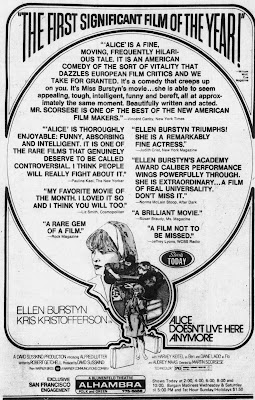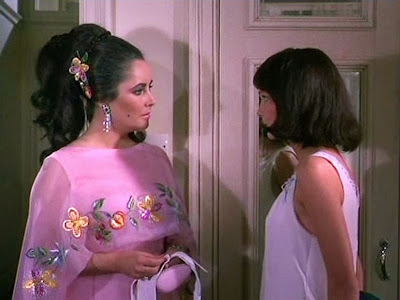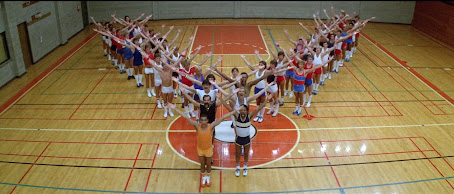Given how so many of my favorite movies are films I first saw while working as an usher at San Francisco’s Alhambra Theater on Polk
Street (it still stands, currently a Crunch gym), it's no wonder that I tend to look back upon my high school years working there as my preparatory film school education (after graduation I studied film at The San Francisco Art Institute).
The Alhambra was a beautiful, ornate, old-fashioned first-run theater (until they split it into two), but as it was considered the neighborhood sister-theater to the ritzier, high-end Regency Theater on Sutter, it was the custom for the Alhambra to be assigned the low-budget and independent first-run films. Thus, it was something of a fluke when the Alhambra was chosen as the site of Alice Doesn’t
Live Here Anymore's exclusive San Francisco engagement in February of 1975 (the post-Christmas "dog days" of movie exhibition) and proved to be the breakout hit of the new year.
Ellen Burstyn was popular after her Oscar-nominated turn in The Exorcist (1973), but female-driven narratives were still so rare in the male-centric '70s that Alice Doesn’t Live Here Anymore was given a limited release in urban markets to test its appeal (it played in Los Angles a full month before opening in San Francisco). Neither Martin Scorsese nor rock-star-turned-actor Kris Kristofferson had what you'd call marquee names at the time, so expectations for the film were modest, and advance publicity minimal.
 |
| Ellen Burstyn as Alice Hyatt |
 |
| Alfred Lutter as Tommy Hyatt |
Alice Doesn't Live Here Anymore—the story of a newly widowed housewife (Burstyn) who sets off on the road with her 12-year-old son to become a singer in Monterey, California—from a marketing angle, didn't have much in the way of publicity bait (no hookers, no gunplay, no nudity, no car chases), yet I recall it as being the biggest film to play the Alhambra during my time there. As one of those films that opens slowly, only to boom practically overnight, Alice Doesn't Live Here Anymore had sold-out screenings and lines stretching around the corner for nearly the entirety of its exclusive engagement. Patrons came back to see the film two and three times, almost always with someone new in tow to whom they'd recommended it. I had never seen anything like it. A true word-of-mouth hit. And what amazed me even more was the high volume of elderly people this film attracted. For some reason (the film's nostalgic tone, perhaps), older audiences—a market largely ignored by the youth films of the day—absolutely flocked to this movie! Sunday matinees looked like an AARP convention.
 |
| Somewhere Over the Rainbow...with a really foul mouth Mia Bendixson portrays 8-year-old Alice in the Wizard of Oz-inspired opening sequence |
WHAT I LOVE ABOUT THIS FILM
There are several books, online articles, and even a DVD commentary
detailing the significant role Ellen Burstyn played in getting Alice Doesn’t Live Here Anymore made. Aside
from the almost mythic appeal of the story (a feminist collaborates with
a famously male-centric director to make a film considered by many to be the quintessential
cinematic articulation of the '70s women’s movement), what comes through
strongest is the passion and commitment of everyone involved.
Martin Scorsese speaks of having the foreknowledge of the studio expecting him to turn out a genre film—a romantic comedy with a happy ending—yet he and Burstyn turn in a film of such unexpected freshness, I still find myself dazzled by it. Its characters, settings, dialogue, and character-based humor felt so refreshingly personal, so original, and so surprising. Scorsese succeeds in creating a '70s revisionist take on the '40s woman's picture, something he endeavored (with considerably less success) with the '40s musical genre when he made New York, New York in 1977. Now there's a film that could have benefited from Ellen Burstyn's level-headed feminine perspective.
Martin Scorsese speaks of having the foreknowledge of the studio expecting him to turn out a genre film—a romantic comedy with a happy ending—yet he and Burstyn turn in a film of such unexpected freshness, I still find myself dazzled by it. Its characters, settings, dialogue, and character-based humor felt so refreshingly personal, so original, and so surprising. Scorsese succeeds in creating a '70s revisionist take on the '40s woman's picture, something he endeavored (with considerably less success) with the '40s musical genre when he made New York, New York in 1977. Now there's a film that could have benefited from Ellen Burstyn's level-headed feminine perspective.
 |
| I'd never seen an onscreen mother/son relationship like the one Alice and Tommy share |
Scorsese’s fluid visual style gives the film a gritty kind
of grace, while his laser-sharp editing has a way of turning simple cuts into
clever visual punchlines. The performances are uniformly first-rate (I have a
particular fondness for the sweetly oddball waitress, Vera. I always wanted to know
more about her character's life), and the very funny screenplay never scarifies character or theme for an easy laugh.
PERFORMANCES
True to the axiom that comedy never gets any respect, whenever
I think about my favorite film performances by an actress in the '70s, my mind
goes straight to Jane Fonda in They Shoot Horses,Don’t They? and Klute, Faye
Dunaway in Chinatown, Karen Black in The Day of the Locust, or Glenda Jackson in anything. I always overlook the absolutely
astonishing job Ellen Burstyn does in bringing the character of Alice Hyatt to
life. I thought so in 1974, and looking at the film again after so many years, it still stands out as such a thoroughly realized performance. And by that, I mean Burstyn makes Alice Hyatt so authentic an individual, you honestly feel as though you have been observing a real person, not a fictional character. She is no male fantasy construct. She's not even a Women's Lib figurehead; she only seemed so when compared to the type of degrading roles being offered women during the '70s.
The depth of Burstyn's performance has the effect of fulfilling what the premise of the film promises: an ordinary woman is revealed to be remarkable by sheer force of her humanity. Alice goes from being someone's wife and mother to being the standout heroine of her own life. And it's the talent of Ellen Burstyn, giving an Academy Award-winning performance, that makes it happen.
The Academy got it right in awarding Burstyn the Best Actress Oscar, but seriously dropped the ball with the terrific Diane Ladd. Her folksy waitress, Flo, is one of the screen's great character performances. By the way, back when I was a movie usher, Flo's frustrated outburst: "She went to shit and the hogs ate her!" got the longest, loudest laugh I'd ever heard in a movie theater, yet it was also the single moment in the film I was most questioned about by departing patrons. It seemed like every third person came up to me after a screening asking, "What did that waitress say?" Apparently, folks were only able to make out the word "shit" and that (along with Ladd's explosive tone and body language) was sufficient for the scene to work.
When I told them what she'd actually said, their faces almost always registered bewilderment. Like me, not a single individual was familiar with the old saying (referring to someone who should be working but keeps disappearing), plus, I think most people's imaginations had conjured up something far funnier and vulgar, so finding out what was really said inevitably came as something of a letdown.
The depth of Burstyn's performance has the effect of fulfilling what the premise of the film promises: an ordinary woman is revealed to be remarkable by sheer force of her humanity. Alice goes from being someone's wife and mother to being the standout heroine of her own life. And it's the talent of Ellen Burstyn, giving an Academy Award-winning performance, that makes it happen.
The Academy got it right in awarding Burstyn the Best Actress Oscar, but seriously dropped the ball with the terrific Diane Ladd. Her folksy waitress, Flo, is one of the screen's great character performances. By the way, back when I was a movie usher, Flo's frustrated outburst: "She went to shit and the hogs ate her!" got the longest, loudest laugh I'd ever heard in a movie theater, yet it was also the single moment in the film I was most questioned about by departing patrons. It seemed like every third person came up to me after a screening asking, "What did that waitress say?" Apparently, folks were only able to make out the word "shit" and that (along with Ladd's explosive tone and body language) was sufficient for the scene to work.
When I told them what she'd actually said, their faces almost always registered bewilderment. Like me, not a single individual was familiar with the old saying (referring to someone who should be working but keeps disappearing), plus, I think most people's imaginations had conjured up something far funnier and vulgar, so finding out what was really said inevitably came as something of a letdown.
THE STUFF OF FANTASY
In spite of it being a somewhat troublesome film genre with a built-in anecdotal construct that frequently leads to directors being unable to arrive at or maintain a consistent tone, I like road movies a great deal (a personal unsung favorite being the quirky Rafferty & the Gold Dust Twins – 1974). Like most road movies, Alice Doesn't Live Here Anymore has a literal road trip serve as a “journey
of life/path of growth” metaphor, but in this instance, the cliché feels
fresh because Alice’s story—a woman approaching middle age forced to confront
life as a single mother—isn't the kind Hollywood has been falling over
itself in an effort to tell.
Scorsese, Burstyn, and Oscar-nominated screenwriter Robert Getchell (one of the many writers involved in wresting Mommie Dearest to the screen) fashion an engagingly contemporary Alice in Wonderland liberation allegory out of Alice Hyatt’s automobile pilgrimage to, as one writer astutely put it, the Monterey of her mind. Whereas most road films tend to run out of steam somewhere around the midpoint, Alice Doesn’t Live Here Anymore grows increasingly funnier and more emotionally substantial as it goes along. I love the opening scenes in Socorro, New Mexico; the hilarious moments on the road that delineate Alice's unique relationship with her son; and the scenes highlighting Alice's early employment efforts or the ones that show her navigating the choppy waters of dating. But my favorite section—where the film fully hits its comedic stride—are the latter scenes of the film that take place in Tucson, Arizona. Specifically those within Mel & Ruby's Diner.
Being at turns funny, gritty, touching, dramatic, and very sweet, Alice Doesn’t Live Here Anymore is a movie that covers a great deal of ground. But throughout, the film somehow sustains that amazingly delicate balance of being true to its genre conventions while still being a solid character drama focusing on people we come to really know and care a great deal about. Best of all, it gives us a story of an individual's journey of self-discovery that is also one of the most well-rounded, dimensional portraits of a woman ever committed to film.
 |
| The depiction of the friendship that develops between the superficially dissimilar Alice and Flo is one of the best things in the film |
THE STUFF OF DREAMS
A lot has been written about Alice Doesn’t Live Here Anymore’s somewhat problematic ending. An ending
(two, actually, if you count the brief coda after the diner scene) suggesting Alice, after finding the love of a good man (a
ranch-owning, dreamboat of an eligible bachelor who also happens to be the only guy for miles around who
doesn't look like an extra from Hee Haw)
is going to table her dream of going to Monterey. This Warner Bros-mandated ending proved a real crowd-pleaser with '70s audiences growing weary of all that New Hollywood nihilism, thus making Alice Doesn’t Live Here Anymore one of the top-grossing films of 1974. And
while many welcomed the change of pace that an old-fashioned Hollywood happy
ending presented, others were dismayed by the extent to which the chosen ending conflicted
with—if not outright contradicted—much of what preceded it.
Had Alice Doesn’t Live
Here Anymore been just one of many films made during the '70s that told a
story from a woman’s point of view, audiences would likely have accepted the
ending as being merely a choice suitable for this particular character (after
all, as the honey-tones of the opening sequence imply, Alice’s memories of her
life in Monterey are likely as idealized as the scope of her early singing
career). But being that the vast majority of roles available to women in the '70s could
be typified by Karen Black’s catalog of supportively deferential, frequently-abandoned
trollops, a disproportionate amount of feminist significance was therefore placed
on Alice Hyatt and her personal journey of self-discovery.
As is my wont, I’m of several minds about the ending.
 |
| That's 6-year-old Laura Dern (daughter of Diane Ladd and Bruce Dern) listening in on Alice and David's conversation |
a) From a movie buff’s perspective, Alice Doesn't Live Here Anymore’s ending feels like a perfect full circle for a film that begins with a title sequence (cursive lettering on satin) that references the tropes and clichés of the women’s film genre of the '40s. Happy endings were a big part of what many of those 1940's films were about, so thematically, it makes a lot of sense for Alice Doesn't Live Here Anymore to end with what could be described as an updated take on the standard Hollywood happy ending.
b) From a character-based perspective, I think it’s possible to
look upon Alice’s dream of returning to Monterey as a romanticized fantasy…a
retreat to childhood, if you will…that she clings to in the midst of an unhappy
marriage. In this light, her ultimate decision to be with Donald and remain in Tucson
(“If I’m gonna be a singer I can be a
singer anywhere, right?”) indicates a newfound maturity and personal growth
on her part. She’s gained the ability to find happiness in her life as it is
lived in the present, not by trying to return to an idealized happier time in
her past.
c) It’s only when I look at the film from an ideological or sociological perspective that I have a problem with the ending. And that’s largely the film’s fault for establishing such a compelling narrative trajectory. One that takes us from the words of Alice’s friend Bea at the start of the film: “Well, I sure couldn’t live without some kind of man around the house, and neither could you.”; to Alice’s declaration near the end: “It’s my life! It’s not some man’s life I’m here to help him out with!”
So many '70s films ended with the male protagonist leaving
behind a girlfriend or wife in order to find themselves (think Jack Nicholson
in Five Easy Pieces), that it
virtually became a cliché. In each instance, the ending is presented as a happy and necessary step toward independence and self-growth. Given how Alice Doesn't Live Here Anymore sets itself up as a challenge to the long-held
belief that a woman’s life has little to no value without a man, who can be blamed
for wishing this brilliant film had ended with a repudiation of that persistent myth?

































































.JPG)



